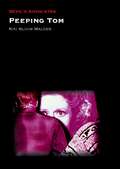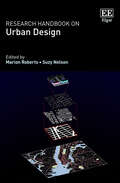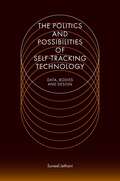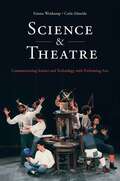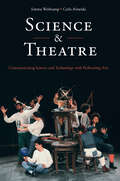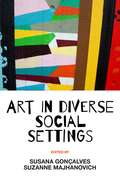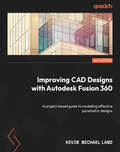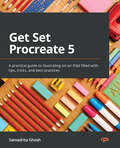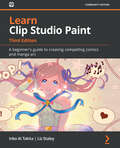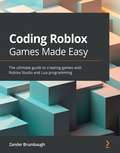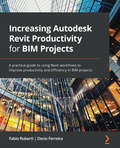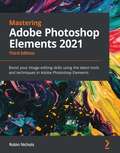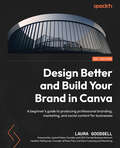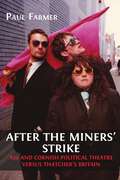- Table View
- List View
Peeping Tom (Devil's Advocates)
by Kiri WaldenReviled on its release, Peeping Tom (1960) all-but ended the career of director Michael Powell, previously one of Britain's most revered filmmakers. The story of a murderous cameraman and his compulsion to record his killings, Powell's film stunned the same critics who had acclaimed him for the work he'd made with writer-producer Emeric Pressburger (The Life and Death of Colonel Blimp, 1943; A Matter of Life and Death, 1946), resulting in the film falling out of circulation almost as soon as it was released. It took the 1970s 'Movie Brat' generation to rehabilitate the director, and the film, which is now regarded as a masterpiece. In this Devil's Advocate, published to coincide with the film's 60th anniversary, Kiri Walden charts the origins, production and devastating critical reception of Peeping Tom, comparing it to the treatment meted out to its contemporary horror classic, Alfred Hitchcock's Psycho (1960).
Safeguarding Intangible Cultural Heritage: A Practical Interpretation of the 2003 UNESCO Convention (Elgar International Law and Practice series)
by Janet BlakeThis book presents a detailed analysis of the different approaches and measures for implementing the requirements of UNESCO’s 2003 Convention on Safeguarding Intangible Cultural Heritage (the Convention) and a practical interpretation of that treaty, based on the experience of States’ Parties and other primary actors. The book considers the interests of multiple stakeholders and takes account of how the Convention interacts with other international law regimes pertaining to both human rights and sustainable development.Key Features:Provides clear and concise information of the definition, scope and significance of intangible cultural heritageUtilises a wide-range of case studies to illustrate the application of the Convention on the ground.Considers the position of multiple stakeholders including national heritage organisations and non-state actorsOutlines practical strategies and solutions for protecting and promoting cultural heritage and looks ahead to potential future developments in this field.Easy to follow structure, mapping out the treaty’s provisions thematically and highlighting their practical applicationProviding accessible and focused analysis, this book will be essential reading for lawyers and practitioners involved in the protection of intangible cultural heritage from both governmental and non-governmental institutions. The book will also be a valuable resource to academics and researchers working across various disciplines including law, heritage, and anthropology.
Research Handbook on Urban Design
With the UN-Habitat estimating that by 2035 the majority of the world’s population will be living in metropolitan areas, this cutting-edge Research Handbook explores the emerging field of urban design and its place in contemporary scholarship.Gathering together a broad spectrum of eminent and up-and-coming scholars across the globe, Marion Roberts and Suzy Nelson demonstrate the depth and rigour of 21st century urban design research. Contributors explore a wide range of topics such as effectively aligning urban design and landscape; reshaping the sustainable city; crisis and temporary public spaces; indigenous urbanism; and designing a healthy neighbourhood. Combining theoretical knowledge with practical application, this erudite Research Handbook analyses key literature in the field supported by an in-depth examination of international case studies.Offering an extensive cross-disciplinary overview of urban design scholarship, this Research Handbook will prove an enlightening read for academics and researchers in urban design, planning, urban studies, landscape architecture, human geography and cultural studies. Its wealth of specialist knowledge will also benefit urban design, city and planning practitioners alike.
The Politics and Possibilities of Self-Tracking Technology: Data, Bodies and Design
by Suneel JethaniCollecting data about our lives, our bodies and our behaviours has become a part of everyday practice that promises greater self-awareness, healthier living and increased productivity. This book focuses on the dialectical relationship between users and designers of self-tracking technology to examine how logics of datafication redefine the body. It explores what these emerging relations mean for imagining, designing and analysing sociotechnical systems that bring about self-tracking. Jethani provides a genealogy of self-tracking to situate the notions of quantified and quantifiable selves as problematic data regimes within contemporary digital culture. It charts the origins of self-tracking from within the blueprint of the "Californian Ideology" to a global social movement which now reaches beyond self-experimentation to encompass the wider trajectories of using wearable sensor technology in the neoliberal management of health, wellbeing and productivity. The book reframes and theorises the quantified self by re-examining and developing arguments of how bodies "disappear" (Jewson), are made "docile" (Foucault) and get caught up in "rhythms" (Lefebvre) by datafication. The concept of a "quantised" self is introduced as a means of reading into and exposing the inherent political interests being served when self-tracking technology is introduced into clinical, home and workplace settings. Drawing from case studies of self-tracking in practice, the final chapter sketches the outline of a mutual praxis of critique and design that allows us to reimagine the politics embedded in sociotechnical systems of self-tracking and to consider possibilities of intervention.
The Politics and Possibilities of Self-Tracking Technology: Data, Bodies and Design
by Suneel JethaniCollecting data about our lives, our bodies and our behaviours has become a part of everyday practice that promises greater self-awareness, healthier living and increased productivity. This book focuses on the dialectical relationship between users and designers of self-tracking technology to examine how logics of datafication redefine the body. It explores what these emerging relations mean for imagining, designing and analysing sociotechnical systems that bring about self-tracking. Jethani provides a genealogy of self-tracking to situate the notions of quantified and quantifiable selves as problematic data regimes within contemporary digital culture. It charts the origins of self-tracking from within the blueprint of the "Californian Ideology" to a global social movement which now reaches beyond self-experimentation to encompass the wider trajectories of using wearable sensor technology in the neoliberal management of health, wellbeing and productivity. The book reframes and theorises the quantified self by re-examining and developing arguments of how bodies "disappear" (Jewson), are made "docile" (Foucault) and get caught up in "rhythms" (Lefebvre) by datafication. The concept of a "quantised" self is introduced as a means of reading into and exposing the inherent political interests being served when self-tracking technology is introduced into clinical, home and workplace settings. Drawing from case studies of self-tracking in practice, the final chapter sketches the outline of a mutual praxis of critique and design that allows us to reimagine the politics embedded in sociotechnical systems of self-tracking and to consider possibilities of intervention.
Science & Theatre: Communicating Science and Technology with Performing Arts
by Emma Weitkamp Carla AlmeidaThere has been a significant growth in initiatives involving theatre, drama and performance within a science communication context. Yet there is little scholarship exploring this phenomenon from a science communication perspective. Weitkamp and Almeida draw on their distinct experiences with theatre in the context of science communication to delve into initiatives created through dialogue between the arts and the sciences for the purpose of public engagement. Entering into the space where museums, universities and research centres operate, as well as the space of theatre practitioners, they explore the richness and plurality of this universe, combining theory and practice, as well as presenting context, knowledge gaps and new data. Acknowledging that the place of drama, theatre and performance within science communication is one which is uniquely influenced by local cultural practices, discourses and expectations, the authors take a global perspective. Firstly by analysing data from an international survey of practitioners and secondly by curating a collection of case studies on science-theatre projects undertaken around the world. The chapters illustrate the diversity of forms and content that comprises contemporary science-theatre in this context and characterise theatre produced within the scope of science communication, placing it more precisely in the broader context of science-theatre.
Science & Theatre: Communicating Science and Technology with Performing Arts
by Emma Weitkamp Carla AlmeidaThere has been a significant growth in initiatives involving theatre, drama and performance within a science communication context. Yet there is little scholarship exploring this phenomenon from a science communication perspective. Weitkamp and Almeida draw on their distinct experiences with theatre in the context of science communication to delve into initiatives created through dialogue between the arts and the sciences for the purpose of public engagement. Entering into the space where museums, universities and research centres operate, as well as the space of theatre practitioners, they explore the richness and plurality of this universe, combining theory and practice, as well as presenting context, knowledge gaps and new data. Acknowledging that the place of drama, theatre and performance within science communication is one which is uniquely influenced by local cultural practices, discourses and expectations, the authors take a global perspective. Firstly by analysing data from an international survey of practitioners and secondly by curating a collection of case studies on science-theatre projects undertaken around the world. The chapters illustrate the diversity of forms and content that comprises contemporary science-theatre in this context and characterise theatre produced within the scope of science communication, placing it more precisely in the broader context of science-theatre.
Art in Diverse Social Settings
by Susana Gonçalves Suzanne MajhanovichThis edited collection examines the important and multi-varied role that art plays in today's diverse society. Art is linked to the worldviews and mind-sets from which it results and, as a complex and ambiguous product of culture and perception, it can only be truly understood from multiple perspectives. Recognising this, Art in Diverse Social Settings brings together contributions from a diverse range of authors - including scholars and artists from different countries, artistic languages and art statements - to give fresh perspectives on central questions such as: What purpose(s) do the arts serve in contemporary diverse and pluralistic societies? What are the links between art and citizenship in a 'glocal' perspective? Can aesthetics be compared to faith, therapy or civic resistance? Is art a feasible tool to prevent and contest social injustice, raise social consciousness and resistance in the political arena? Can art promote social inclusion? How can artistic practices contribute to community development? The book contains three parts including Part 1 with theoretical chapters, and Parts 2 and 3 that present exemplary case studies illustrating art as a medium for communication and intervention in professional organizations, public spaces and/or the community.
Art in Diverse Social Settings
by Susana Gonçalves Suzanne MajhanovichThis edited collection examines the important and multi-varied role that art plays in today's diverse society. Art is linked to the worldviews and mind-sets from which it results and, as a complex and ambiguous product of culture and perception, it can only be truly understood from multiple perspectives. Recognising this, Art in Diverse Social Settings brings together contributions from a diverse range of authors - including scholars and artists from different countries, artistic languages and art statements - to give fresh perspectives on central questions such as: What purpose(s) do the arts serve in contemporary diverse and pluralistic societies? What are the links between art and citizenship in a 'glocal' perspective? Can aesthetics be compared to faith, therapy or civic resistance? Is art a feasible tool to prevent and contest social injustice, raise social consciousness and resistance in the political arena? Can art promote social inclusion? How can artistic practices contribute to community development? The book contains three parts including Part 1 with theoretical chapters, and Parts 2 and 3 that present exemplary case studies illustrating art as a medium for communication and intervention in professional organizations, public spaces and/or the community.
Improving CAD Designs with Autodesk Fusion 360: A project-based guide to modelling effective parametric designs
by Kevin Michael LandWork through multiple design projects to understand how Autodesk Fusion 360 helps improve efficiency and drafting Purchase of the print or Kindle book includes a free PDF eBookKey FeaturesUnderstand the project workflow of Autodesk Fusion 360Design and redesign projects while learning to fix errorsGain a better insight into repurposing real-world items into Fusion 360 for custom designsBook DescriptionAutodesk Fusion 360 has become an indispensable tool for designers, tinkerers, and engineers worldwide thanks to its versatility that allows for large-scale assemblies and smaller, quick 3D prints. If you’ve faced challenges with learning Fusion 360, this book will help you overcome them and build the confidence to design your own projects, explaining step-by-step instructions and the purpose of each tool. In this book, you’ll dive into the design workspace and learn sketching fundamentals such as setting up a component, recognizing when a sketch is fully constrained, and parametrically flexing models. Through trial and error, you’ll work on multiple easy-to-build projects to create simple, useful items that can be quickly 3D printed for use around the house and then advance to much bigger projects that require joint connectivity and large assemblies. By the end of this book, you’ll be able to sketch fully parametric designs, translate them into 3D models, and create your own unique designs.What you will learnGain proficiency in Fusion 360 user interface, navigation, and functionalityCreate and transform simple 2D sketches into 3D modelsManipulate and control parametric 2D sketches using dimensionsBecome familiar with drafting on paper and taking measurements with calipersCreate a bicycle assembly part with Fusion 360Use the form environment to create organic shapesRender a 3D model and understand how to apply materials and lightingGenerate 2D assembly model drawings for documentation purposesWho this book is forBeginner or intermediate designers who prefer hands-on learning will find this book useful, especially designers, woodworkers, 3D printing enthusiasts, and hobbyists who enjoy creating things, rather than experienced machinists. The basic projects are accessible without prior CAD skills, although some fundamental CAD understanding is beneficial for those interested in going further. It is highly recommended that you use a 3-button mouse for all projects to fully utilize floating pop-up menus.
Get Set Procreate 5: Tips, Tricks, And Best Practices For Illustrating On An Ipad
by Samadrita GhoshLearn Clip Studio Paint (PDF): A Beginners Guide To Creating Compelling Comics And Manga Art
by Inko Liz StaleyDiscover the tools to tell your own manga story with Clip Studio Paint and develop your digital drawing skills Key Features Gain a clear understanding of Clip Studio Paint and create your own manga stories Learn to put CSP into practice by implementing it in real-world drawing scenarios Discover how to apply digital drawing techniques to your creation using CSP Book Description Clip Studio Paint is a versatile digital painting program for creating manga and illustrations, helping artists expand their digital portfolio. This software is packed with tools that make panel laying, speech adding, toning, and editing much easier. This easy-to-follow guide is clearly divided into chapters covering drawing tools, interface customization, and using various visual effects so you can focus on specific techniques in detail one at a time. Learn Clip Studio Paint is a comprehensive introduction for those who are new to Clip Studio Paint that will have you up to speed in no time. You'll start by experiencing what it's like to create manga digitally and find new ways to shape your drawing. Next, using practical tips and rich visual references, the book shows you how to apply techniques to your creations, giving you the opportunity to expand your range of visual expression. As you advance, you'll explore how to create special effect brushes using an in-depth example, along with discovering how to color, blend, and edit your art digitally. Finally, you'll find out how to print, use the Clip Studio Paint Assets, and learn how to create unique and inspiring art that stands out from the rest. By the end of this Clip Studio Paint book, you'll have gained a clear understanding of its tools and be able to start telling your own manga story using your improved digital drawing skills. What you will learn Explore Clip Studio Paint and create your own manga stories Familiarize yourself with the CSP ecosystem Use Clip Studio Paint Pro's inking tools and find ways to customize your art Explore the flexibility of the brush engine in Clip Studio Paint Pro Use palettes to generate colors between foreground and background colors Find out alternative ways of coloring your manga art using black, white, and grey Discover how to use layer blending to add textures to your images Who this book is for If you're just starting out as a digital artist or want to switch to Clip Studio Paint from a different graphics software package, then this book is for you. Those with no prior knowledge of digital art or intermediate-level users looking to explore the unique features of Clip Studio Paint will also find this book useful.
Coding Roblox Games Made Easy: The ultimate guide to creating games with Roblox Studio and Lua programming
by Zander BrumbaughGet up and running with Roblox development with the help of expert guidance for working with Roblox components and Lua programmingKey FeaturesDiscover solutions to common problems faced while creating games on RobloxExplore tips, tricks, and best practices and learn advanced Roblox coding techniques to create gamesUnderstand how to program in the Roblox Lua language, add engaging effects, add a variety of functionalities, and much moreBook DescriptionRoblox is a global virtual platform like no other for both playing and creating games. With well over 150 million monthly active users, Roblox hosts all genres of games that can be played by other members of the community using the Lua programming language. Not only can you create games for free, but you can also earn considerable sums of money if from the success of your games, and become part of the vast and supportive developer circle that provides excellent opportunities for networking in a tight-knit community. With this practical book, you'll get hands-on experience working on the Roblox platform. You'll start with an overview of Roblox development and then understand how to use Roblox Studio. As you progress, you'll gradually learn everything you need from how to program in Roblox Lua to creating Obby and Battle Royale games. Finally, you'll delve into the logistics of game production, focusing on optimizing the performance of your game by implementing impressive mechanics, monetization, and marketing practices. By the end of this Roblox book, you'll be able to lead or work with a team to bring your gaming world to life, and extend that experience to players around the world.What you will learnGet started with Roblox development and explore aspects such as choosing a developer typeUnderstand how to use Roblox Studio and other free resourcesCreate your first game with the Roblox Lua programming languageBecome well-versed with the three Ms - Mechanics, Monetization, and MarketingDevelop real-world games such as Battle Royale and ObbyDiscover expert tips for collaborating effectively and managing project workloadsWho this book is forThis Roblox guide is for anyone interested in learning how to develop games on the Roblox platform. If you're already familiar with Roblox and looking for tips, tricks, and Roblox and Lua best practices for efficient development, you'll find this book helpful.
Increasing Autodesk Revit Productivity For Bim Projects: A Practical Guide To Using Revit Workflows To Improve Productivity And Efficiency In Bim Projects
by Fabio Roberti Decio FerreiraA practical guide to using Revit workfl ows to improve productivity and effi ciency in BIM projects
Mastering Adobe Photoshop Elements 2021: Boost your image-editing skills using the latest tools and techniques in Adobe Photoshop Elements
by Robin NicholsLeverage this well-illustrated, easy-to-understand end-to-end guide to become an accomplished photo editor, image retoucher, and creative artistKey FeaturesUpdated to the latest version of Photoshop Elements 2021 with focused coverage of Adobe's latest AI technologyOrganize, search, and manage an ever-increasing number of images and videos using expert practicesUncover common solutions to a wide range of photographic and image-editing problemsBook DescriptionManaging thousands of images while producing perfectly edited results is now a must-have skill for online bloggers, influencers, vloggers, social media users, and photography enthusiasts. Photoshop Elements helps you to manage this easily and boost your creative output. This third edition is updated with Elements 2021's latest features and focuses on Adobe's AI-powered features along with the entire creative workflow. Each chapter is designed to help you get the most out of your image files in an easy way. You'll learn how to add significant visual improvements to your work using no more than a few one-click edits with AI-driven features and manual adjustments. The book is filled with useful instructions to guide you seamlessly through the often complex processes, tools, and features in Photoshop Elements. Finally, you'll cover everything from developing your organizational skills through to creating remarkable special effects, complex text, image combinations, and eye-popping visual techniques using both AI-driven features as well as manually operated tools. By the end of this Photoshop Elements book, you'll have learned how to leverage the impressive tools available in Photoshop Elements 2021, and use them to greatly improve your photo editing and image retouching skills.What you will learnIdentify the five parts of Elements and set up your computer, camera, and monitorImport, organize, and keep track of your imported media libraryDevelop advanced image retouching skillsDiscover how to add text and graphics to photographsCultivate your understanding of multi-image, multi-layered editing techniquesDevelop illustrative skills with the many drawing tools available in Elements 2021Prepare images and projects for uploading to social media, print, and videoFind out how to troubleshoot your work when things don't come out the way you hoped they wouldWho this book is forThis book is for amateur photographers looking to dip their toes into the editing world, anyone who wants simple but effective ideas on how to expand their creativity, as well as advanced enthusiasts seeking to push the boundaries of their creative output. Though not necessary, photography skills together with basic photo editing knowledge will help you to get the most out of this book.
Design Better and Build Your Brand in Canva: A Beginner's Guide To Producing Professional Branding, Marketing, And Social Content For Businesses
by Laura GoodsellA beginner’s guide to producing professional branding, marketing, and social content for businesses
Circulation and Control: Artistic Culture and Intellectual Property in the Nineteenth Century
by Marie-Stéphanie Delamaire And Will SlauterThe nineteenth century witnessed a series of revolutions in the production and circulation of images. From lithographs and engraved reproductions of paintings to daguerreotypes, stereoscopic views, and mass-produced sculptures, works of visual art became available in a wider range of media than ever before. But the circulation and reproduction of artworks also raised new questions about the legal rights of painters, sculptors, engravers, photographers, architects, collectors, publishers, and subjects of representation (such as sitters in paintings or photographs). Copyright and patent laws tussled with informal cultural norms and business strategies as individuals and groups attempted to exert some degree of control over these visual creations. With contributions by art historians, legal scholars, historians of publishing, and specialists of painting, photography, sculpture, and graphic arts, this rich collection of essays explores the relationship between intellectual property laws and the cultural, economic, and technological factors that transformed the pictorial landscape during the nineteenth century. This book will be valuable reading for historians of art and visual culture; legal scholars who work on the history of copyright and patent law; and literary scholars and historians who work in the field of book history. It will also resonate with anyone interested in current debates about the circulation and control of images in our digital age.
The Form of Ideology and the Ideology of Form: Cold War, Decolonization and Third World Print Cultures
by Francesca Orsini;Neelam Srivastava and Laetitia ZecchiniThis timely volume focuses on the period of decolonization and the Cold War as the backdrop to the emergence of new and diverse literary aesthetics that accompanied anti-imperialist commitments and Afro-Asian solidarity. Competing internationalist frameworks produced a flurry of writings that made Asian, African and other world literatures visible to each other for the first time. The book’s essays examine a host of print culture formats (magazines, newspapers, manifestos, conference proceedings, ephemera, etc.) and modes of cultural mediation and transnational exchange that enabled the construction of a variously inflected Third-World culture which played a determining role throughout the Cold War. The essays in this collection focus on locations as diverse as Morocco, Tunisia, South Asia, China, Spain, and Italy, and on texts in Arabic, English, French, Hindi, Italian, and Spanish. In doing so, they highlight the combination of local debates and struggles, and internationalist networks and aspirations that found expression in essays, novels, travelogues, translations, reviews, reportages and other literary forms. With its comparative study of print cultures with a focus on decolonization and the Cold War, the volume makes a major contribution both to studies of postcolonial literary and print cultures, and to cultural Cold War studies in multilingual and non-Western contexts, and will be of interest to historians and literary scholars alike.
Documentary Making for Digital Humanists: (pdf) (Open Field Guides Series #2)
by Darren R. Reid Brett SandersThis fluent and comprehensive field guide responds to increased interest, across the humanities, in the ways in which digital technologies can disrupt and open up new research and pedagogical avenues. It is designed to help scholars and students engage with their subjects using an audio-visual grammar, and to allow readers to efficiently gain the technical and theoretical skills necessary to create and disseminate their own trans-media projects. Documentary Making for Digital Humanists sets out the fundamentals of filmmaking, explores academic discourse on digital documentaries and online distribution, and considers the place of this discourse in the evolving academic landscape. The book walks its readers through the intellectual and practical processes of creating digital media and documentary projects. It is further equipped with video elements, supplementing specific chapters and providing brief and accessible introductions to the key components of the filmmaking process. This will be a valuable resource to humanist scholars and students seeking to embrace new media production and the digital landscape, and to those researchers interested in using means beyond the written word to disseminate their work. It constitutes a welcome contribution to the burgeoning field of digital humanities, as the first practical guide of its kind designed to facilitate humanist interactions with digital filmmaking, and to empower scholars and students alike to create and distribute new media audio-visual artefacts.
The Classical Parthenon: Recovering the Strangeness of the Ancient World
by William St ClairComplementing Who Saved the Parthenon? this companion volume sets aside more recent narratives surrounding the Athenian Acropolis, supposedly ‘the very symbol of democracy itself’, instead asking if we can truly access an ancient past imputed with modern meaning. And, if so, how? In this book William St Clair presents a reconstructed understanding of the Parthenon from within the classical Athenian worldview. He explores its role and meaning by weaving together a range of textual and visual sources into two innovative oratorical experiments – a speech in the style of Thucydides and a first-century CE rhetorical exercise – which are used to develop a narrative analysis of the temple structure, revealing a strange story of indigeneity, origins, and empire. The Classical Parthenon offers new answers to old questions, such as the riddle of the Parthenon frieze, and provides a framing device for the wider relationship between visual artefacts, built heritage, and layers of accumulated cultural rhetoric. This groundbreaking and pertinent work will appeal across the disciplines to readers interested in the classics, art history, and the nature of history, while also speaking to a general audience that is interrogating the role of monuments in contemporary society.
Second Chance: My Life in Things
by Ruth RosengartenIn this intimate memoir, Ruth Rosengarten explores the subject of evocative objects through a series of interconnected essays. Evocative objects reflect our attitudes to our own lives and how we seek to display ourselves to ourselves. They are therefore, closely linked to our memories, and how we filter, process and reconstruct them. Rosengarten explores the themes and associations invoked by her own evocative objects, which are frequently shabby things of no material value. They are, importantly, often objects that, in their materiality, bear traces of actions, of something-having-been. Through the associative pathways that these objects have paved, she discusses her experiences with the losses she has undergone, her family’s migrations, and what it means to be a childless woman. This leads her to address the question of what will become of her storied objects and the memories attached to them when she is no longer in existence. This memoir offers an interdisciplinary approach to collecting and compiling fragments of one’s life, paying close attention to the evocative objects that embody us. In doing so, these essays explore loss, memory, childlessness, longing, family history, literature and art theory through material entities which reveal the immaterial ‘things’ at the heart of this study. This book is sure to be of interest to anyone stimulated by memory work and the relationship between humans and their possessions.
Performing Deception: Learning, Skill and the Art of Conjuring
by Brian RappertIn Performing Deception, Brian Rappert reconstructs the practice of entertainment magic by analysing it through the lens of perception, deception and learning, as he goes about studying conjuring himself. Through this novel meditation on reasoning and skill, Rappert elevates magic from the undertaking of mere trickery to an art that offers the basis for rethinking our possibilities for acting in the modern world. Performing Deception covers a wide range of theories in sociology, philosophy, psychology and elsewhere in order to offer a striking assessment of the way secrecy and deception are woven into social interactions, as well as the illusionary and paradoxical status of expertise.
Life, Re-Scaled: The Biological Imagination in Twenty-First-Century Literature and Performance
by Liliane Campos and Pierre-Louis PatoineThis edited volume explores new engagements with the life sciences in contemporary fiction, poetry, comics and performance. The gathered case studies investigate how recent creative work reframes the human within microscopic or macroscopic scales, from cellular biology to systems ecology, and engages with the ethical, philosophical, and political issues raised by the twenty-first century’s shifting views of life. The collection thus examines literature and performance as spaces that shape our contemporary biological imagination. Comprised of thirteen chapters by an international group of academics, Life, Re-Scaled: The Biological Imagination in Twenty-First-Century Literature and Performance engages with four main areas of biological study: ‘Invisible scales: cells, microbes and mycelium’, ‘Neuro-medical imaging and diagnosis’, ‘Pandemic imaginaries’, and ‘Ecological scales’. The authors examine these concepts in emerging forms such as plant theatre, climate change art, ecofiction and pandemic fiction, including the work of Jeff Vandermeer, Jon McGregor, Jeff Lemire, and Extinction Rebellion’s Red Rebel Brigade performances. This valuable resource moves beyond the biological paradigms that were central to the nineteenth and twentieth centuries, to outline the specificity of a contemporary imagination. Life, Re-Scaled is crucial reading for academics, scholars, and authors alike, as it proposes an unprecedented overview of the relationship between literature, performance and the life sciences in the twenty-first century.
William Rimmer: Champion of Imagination in American Art
by Dorinda EvansWilliam Rimmer (1816–1879) is arguably the first modernist American sculptor, although his inventive originality has not been fully acknowledged. Rimmer cultivated an art of ideas and personal expression whilst supporting himself as a physician and, later, as a teacher of art anatomy at the Cooper Union School of Design for Women in New York. Unlike his contemporaries, he advocated the creation of sculpture drawn entirely from the artist’s imagination, as opposed to antique archetypes or live models. In this way, he sought to reframe excellence in American art as something that must be found within, rather than derived from Europe. In this new monograph, the meaning of Rimmer’s works is for the first time considered from a combination of perspectives, such as close visual analysis (including X-ray and infrared), historical documentation, and social context. These are enriched with discussion of the artist’s own bipolar disorder, deeply-held spiritualism, and views on gender equality—considering women just as talented as men, he used naked male models in all-female classes long before his contemporaries, and produced an allegorical sculpture of fighting lions that criticized the tyranny of men over women. This book will be of great interest to academics, students, art museums, collectors, dealers, art historians, and members of the public with an affinity for Rimmer’s work. It will also appeal to those with a broader interest in American culture.
After the Miners’ Strike A39 and Cornish Political Theatre versus Thatcher’s Britain: (pdf)
by Paul FarmerIn this rich memoir, the first of two volumes, Paul Farmer traces the story of A39, the Cornish political theatre group he co-founded and ran from the mid-1980s to the early 1990s. Farmer offers a unique insight into A39’s creation, operation, and artistic practice during a period of convulsive political and social change. The reader is plunged into the national miners’ strike and the collapse of Cornish tin mining, the impact of Thatcherism and ‘Reaganomics’, and the experience of touring Germany on the brink of reunification, alongside the influence on A39 of writers Bertolt Brecht, John McGrath and Keith Johnstone. Farmer, a former bus driver turned artistic director, details the theatre group’s inception and development as it fought to break down social barriers, attract audiences, and survive with little more than a beaten-up Renault 12, a photocopier and two second-hand stage lights at its disposal: the book traces the progress from these raw materials to the development of an integrated community theatre practice for Cornwall. Farmer’s candour and humour enliven this unique insight into 1980s theatre and politics. It will appeal to anyone with an interest in theatre history, life in Cornwall, and the relationship between performance and society during a turbulent era.
